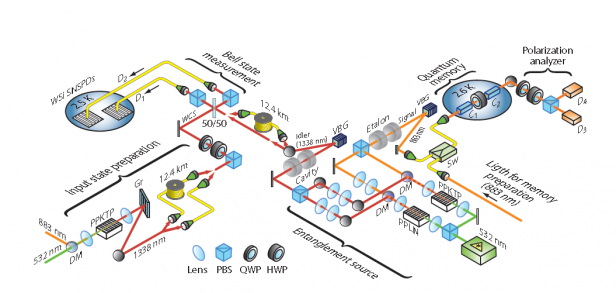Happy 80th birthday, sir! You are one of my heroes...
Biography: "Hammering" Hank Aaron
Happy 80th birthday, sir! You are one of my heroes...
Biography: "Hammering" Hank Aaron
 |
| See link below |
Physics World: Energy can be teleported over long distances, say physicists
| WCPO 9, Cincinnati, Ohio |
Black America Web: Dr. Herbert C. Smitherman Sr.
Cincinnati Herald: Dr. Herbert C Smitherman Sr broke barriers
Cincinnati NAACP: Dr. Herbert C. Smitherman
 |
| Image credit: Physics arXiv link below |
Physics arXiv:
Quantum teleportation from a telecom-wavelength photon to a solid-state quantum memory
WELCOME TO THE VIRTUAL BOOK LAUNCH PARTY!!! Feel Free to leave comments, requests and questions right here. We will have a giveaway every hour!
The blog tour is coming to an end! I want to thank BSFS and Genesis Science Fiction Radio for kicking off the American Spector blog tour weekend! The interview was incredible and you can listen in here: http://www.talkshoe.com/tc/127374
The book launches tomorrow and in celebration I am having a Virtual Book Release Party, on Facebook, Twitter and right here on the BSFS website from 3pm-9pm EST. You can sign up ahead of time on my website www.rasheedahprioleau.com for early bird giveaways.
If you want a sneak peak here you go:
 |
| Amazon Link |
 |
| T-shirt Guru |
Physics World: UK splashes out £270m on quantum technology
 |
| Source: Memory Alpha link below |
Reading for Uhura...
Naming Uhura...
Discussing Uhura...
Quantum Frontiers: Reporting from the ‘Frontiers of Quantum Information Science’
 |
| Source: Omega Deone Wilhite on FB |
Recalling this makes me determined to stay in science, contribute, help when and if I can, and stand on the shoulder of this and other giants (he was actually only 5'6", but you get the idea).
NIST: Quantum Physics Could Make Secure, Single-Use Computer Memories Possible
Hello everyone,
The campaign to get the Earth Squadron futuristic, 3D, Sci-Fi, action film made is well underway!
The team has been working hard behind the scenes on pre-production work so this film will be great.
We have been putting in many weeks of work and late nights creating characters, ships and environments this awesome project.
We need your help to help with the financing of this epic film. Be a part of something groundbreaking project.
Please make a donation towards getting this futuristic tale today at:
http://www.indiegogo.com/projects/earth-squadron-movie-project
 |
| FIG. 2. SEM micrographs of the KTN thin films deposited on (a) MgO and (b) LaAlO3. Citation: J. Appl. Phys. 115, 024103 (2014); http://dx.doi.org/10.1063/1.4858388 |
© 2014 AIP Publishing LLC
Scitation:
Intercomparison of permittivity measurement techniques for ferroelectric thin layers
Dern and Alita rushed through a narrow trench that plunged as deep as eight feet in places.
“The cave is a hundred yards up ahead,” she directed, stepping lightly over sharply uneven ground.
In his suit, Dern moved with a surefootedness verging on grace. Suddenly he stopped, looking around, scrutinizing dim surroundings through ultra-violet optics. A trace of motion thirty yards above triggered faster than normal reflexes. Dern vertical jumped out of the trench, landing on a ridge. He aimed and targeted. Particle clusters flickered from his bracelet, ripping into something that burst apart in a scintillating spray.
Alita had no night sight. Nevertheless, her ears picked up a faint vibratory sound. An object--the sound’s source--floated into the trench a few feet in front of her. She leveled her assault rifle and opened fire. A ripple of rounds penetrated the object. It sputtered and clattered to the ground, rolling functionless at her feet.
She glanced up from the trench to see Dern scurrying along the ridge. “Tracker drones!”
Dern jumped back into the trench. “I know. We’d better make haste. For certain Hooper’s follow-up won’t be so harmless.”
Hooper, like the typical crime lord presiding over an illegal settlement, had an assortment of weapons in his arsenal. Being more prosperous than his peers enabled him to procure the occasional first generation weapons system. Corruption ran deep in parts of the Coalition where avaricious generals and opportunistic arms dealers occasionally conspired to meet the demands of an illicit clientele. For Hooper, one of the benefits of that collaboration was the SkyGuard, a high altitude, aerial bombardment craft armed with Shatter Buster bombs.
The massive blue tinted, wedge configured craft soared like a sluggish carrion bird over the canyon. Bomb bay doors retracted and a tubular object dropped out, plunging several hundred feet before thrusters and stabilizers kicked in. Sensors processed data sent by the trackers and guided the bomb to the fugitives’ last known coordinates.
Dern and Alita bounded into the cave, startling the sleeper ship’s crew.
“It’s just us,” Alita announced. “We ran into a little trouble”
The cave boasted far more space than its small entrance conveyed. Surviving crewmembers were scattered throughout its cool interior, two glow strips alleviating the darkness. The healthy ones tended to the wounded, whose injuries ranged from moderate to the cusp of severe. All would live…for now. Their faces lit with a semblance of hope when they saw Dern.
“I’m just glad you made it back,” said the captain. His expression turned glum when he noticed that Alita was empty handed. “You didn’t get it.”
Alita sighed dejectedly. “Sorry Captain. We were spotted. The pod was destroyed…but I did manage to get a signal off. It hit a contact.”
The captain looked suddenly encouraged.
Dern hated to sour the man’s optimism. “We don’t know who or what the contact is.”
“Maybe it’s a patrol ship,” a crewman with a bandaged eye speculated. “If not, whoever received the signal could reroute it to an available patrol.”
“That could take a long time, longer than we can afford.” Dern removed his helmet. He inhaled deeply, taking in a lungful of dry, musk-tinged air. “In the meantime, we can’t stay in this cave indefinitely.”
“What do you propose?” Asked the captain.
“We get off this planet.”
“With what?”
“The sleeper ship. I’m going to retake it.”
“I have no doubt you could do so with your capabilities,” the captain began. He shook his head, troubled. “But we’ll be shot down before we clear a thousand feet.”
“That’s where Alita comes in,” said Dern. “She operated combat shuttles and quite well I might add.” He turned to the woman. “How about we do a hijacking of our own and seize one of Hooper’s planes. You can provide escort, keep the bogies away from us.”
Alita shrugged agreeably. “Sounds like a great plan to me…”
A deafening boom flooded the cave, followed by a bone jarring jolt that sent anyone standing crashing to the ground.
Rocks large and small rained down blocking the cave entrance, sealing everyone inside. Clouds of dust bubbled into the cave following the rockslide.
Between hacking coughs, Alita scrambled to her feet. “What happened?!?”
The Captain moved to calm panicked crewmembers while Dern dashed toward the blocked entranced.
“Looks like Hooper called in an airstrike,” Dern replied. He half turned. “Everyone get down.” He raised his bracelet arm and a brief splash of daylight illumined the cave as a plasma beam blasted a hole through tons of small rocks and boulders.
A second explosion shattered the stillness, near enough to cause a mild tremor, but far enough away to not precipitate a second rock slide.
“Sounds like that one landed a quarter of mile away,” Alita estimated. “Thanks to the trackers, they have a general idea of our location, but not an exact position.”
The captain looked to Dern. “What now?”
“The plan is still on,” said Dern with a cast iron look of determination. “We’re getting the hell off this planet.”
“Perhaps we just hold out here.” Uncertainty and fear clung to the captain’s words. “Maybe…maybe a patrol ship picked up the distress…maybe help is on the way…”
“And maybe it’s not,” Dern dismissed curtly. “Better to take the initiative than wait around hoping for a rescue that’s not likely to occur.” He ventured toward the cave’s mouth and ducked through to the outside. “If not I’m back by daylight, you can start making your own plans.”
Once outside, Dern pulled up directional data on his display. His suit had calculated the last known location of the sleeper ship and from there, estimated Routh’s distance. He was looking at a 43 mile trek to the settlement…50 if he chose a roundabout route. Either way, Hooper’s enforcers…the bulk of them, he was sure… were out here in the middle of nowhere looking for him. None of those goons were expecting him to head to the settlement. And for certain no one in Routh would be expecting an armored intruder in their midst. Not that Dern planned his visitation to be so conspicuous. Chances were Hooper didn’t have all of his aerial assets in play. Otherwise, they would all be in the sky. Perhaps, in light of the craft Dern shot down earlier, Hooper was taking no chances with deploying low altitude flyers.
Dern fine tuned his visual enhancers and active sensors for tracker detection and proceeded forward on ground choked with rocky debris.
Deep within the bowels of the Internet, past decrepit Geo-Cities archives, below Live Journal post regarding unwavering love for Hansen, tucked in a forgotten corner of a low-baud rate server, there exists a lively classifieds bulletin board.
However, this is no ordinary "missed connections", "soiled futon " market place. This is market for wonders, for forbidden objects found where brave men fear to tread. It is a market for outdated technological marvels, arcane works, eldritch objects from a beyond the borders of the ordinary.
The denizens of these boards engage in a brisk trade, seeking to acquire or unload nameless horrors from the Deep, insane robots from a nightmarish future, hire teams of blind ninja assassins, or just adopt a couple of genetic monstrosities.
Below is just a taste of the terrifying and degenerate ads that populate these boards.
Check here, or the Moorsgate Media Twitter feed for more Chaos Classifieds.
My wife has 6 cats, I have them too only one or two at a time. The Egyptians held them in high regard. I keep them in kibbles, my fingerprints worn off from petting. God they love petting.
There is a secret language the cats have. Not between themselves, but with humans. They sit and watch, fixed eyes, transfixed stares and speak in gestures. I believe they can interpret the temple walls, sitting there taking it all in whole like a cameras shutter, then with a meow, a turn of the head agreeing, walking off to do as prescribed. Sounds funny but they sit by their empty bowls of kibbles and of water. They stare unblinking, wrinkling the corner of their eyes ever so slightly, then turning their head, you realize they have not really moved at all. They got you. I am so compelled to fill the bowls, to care for them, not forget them. The grip of compassion, the expressions of comfort, the hand extension and the expectation of feeling the softness of feline fur and hearing the affirming purrrrrr..........damn, they got me trained!
You can go now, I've got things to do and don't tell anyone I spoke to you, humans are such blabber mouths.
 |
| “For the first time, we will identify continents and oceans—and perhaps the signatures of life—on distant worlds,” says NASA in its 30-year vision for astrophysics. (Credit: Technology Review) |
Physics arXiv: Enduring Quests-Daring Visions (NASA Astrophysics in the Next Three Decades)